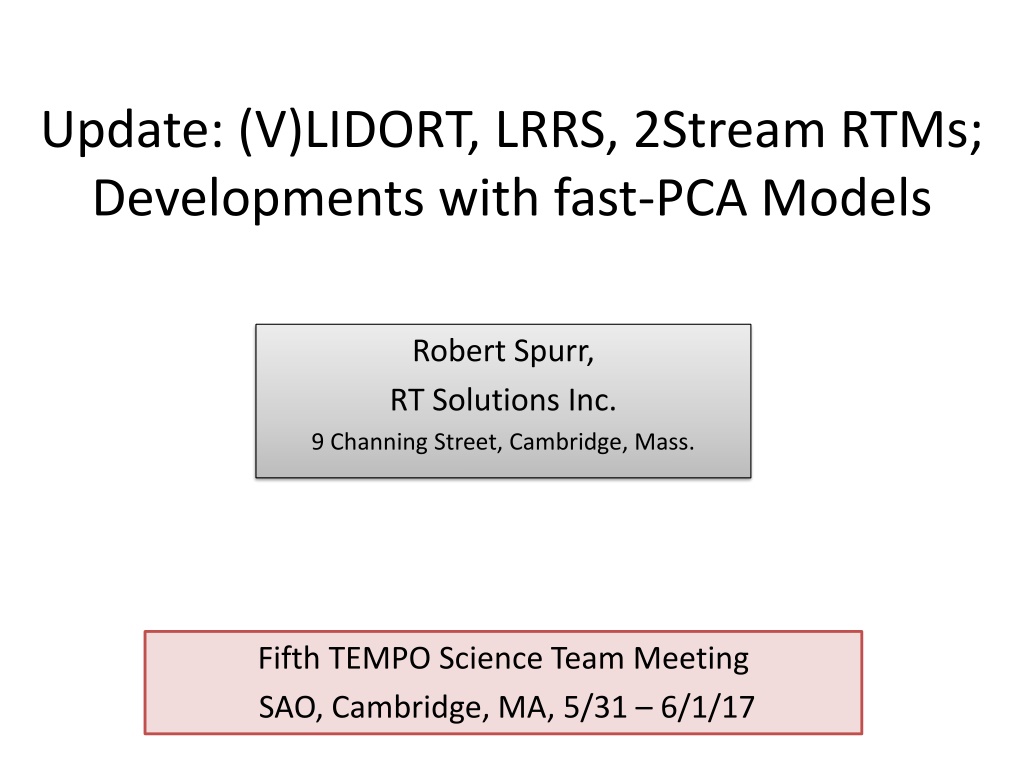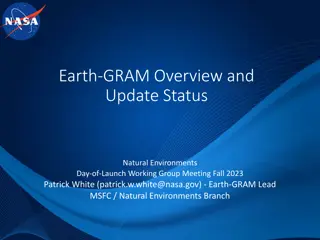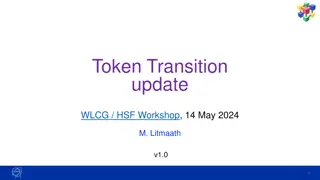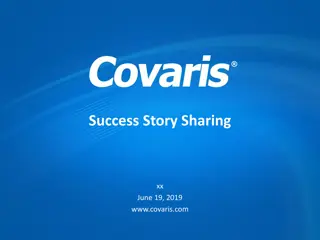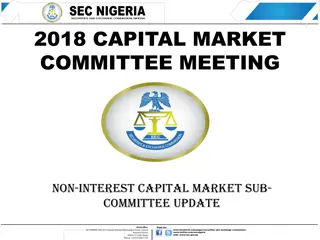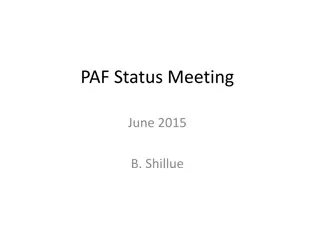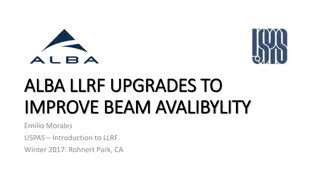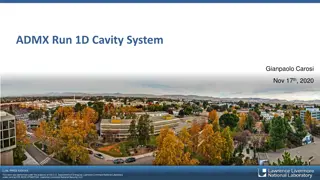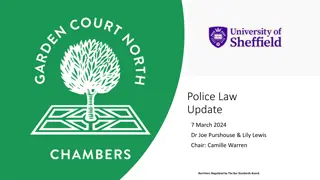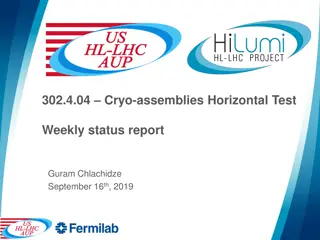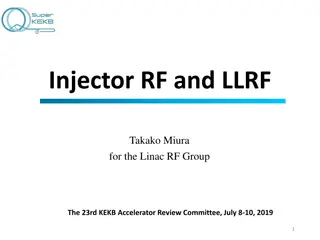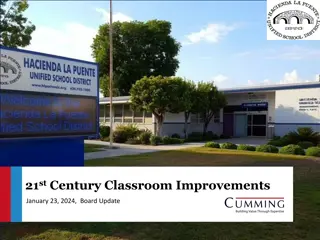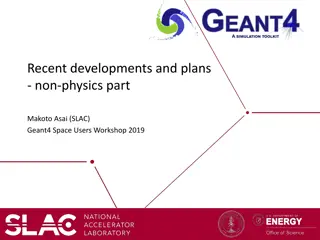Developments in LIDORT and VLIDORT Models: Update and Upgrades
Overview of recent developments in LIDORT, VLIDORT, and related RT models including upgrades to versions 3.8/3.8, enhancements in optical property inputs, new water-leaving radiance treatment, improved BRDF options, and performance enhancements. Upgrades also include the release of LIDORT-RRS version 2.5 with enhanced capabilities. These developments were presented at the Fifth TEMPO Science Team Meeting in Cambridge.
Download Presentation

Please find below an Image/Link to download the presentation.
The content on the website is provided AS IS for your information and personal use only. It may not be sold, licensed, or shared on other websites without obtaining consent from the author. Download presentation by click this link. If you encounter any issues during the download, it is possible that the publisher has removed the file from their server.
E N D
Presentation Transcript
Update: (V)LIDORT, LRRS, 2Stream RTMs; Developments with fast-PCA Models Robert Spurr, RT Solutions Inc. 9 Channing Street, Cambridge, Mass. Fifth TEMPO Science Team Meeting SAO, Cambridge, MA, 5/31 6/1/17
Overview: LIDORT/VLIDORT and other codes : LIDORT discrete ordinate RT is scalar (no polarization); VLIDORT is vector (with polarization). Models are fully linearized for Jacobian output. Other models LRRS/2S/FO (blue box) pseudo-spherical approximation - solar attenuation treated spherically. Precise single scattering Nakajima/Tanaka ansatz, delta-M scaling. Analytically derived Jacobians w.r.t. any profile/column/surface variables thermal emission (Planck functions specified at surface and atmospheric levels BRDF and surface-leaving supplements are separate modules Integrated output is available (regular/actinic fluxes+ Jacobians thereof). OpenMp. Codes operate in parallel computing environments. Currently: Versions 3.7 (LIDORT), 2.7a (VLIDORT). Internet: www.rtslidort.com. Codes freely available. Available from RT SOLUTIONS (rtsolutions@verizon.net) LIDORT-RRS code is a scalar RT code with inelastic rotational-Raman scattering by air molecules.. FO (First-order) model: stand-alone fast/accurate fully linearized spherical single scattering codes. 2STREAM is a fast linearized multiple-scatter-only scalar code for radiances and fluxes. 2OS is a second-order-of-scattering code, Supplement to VLIDORT. [Research Code]. EM codes. Linearized Mie and T-matrix codes . Monochromatic or polydisperse. Various PSDs. 10/2/2024 2 R. Spurr. RT Model Upgrades. Fifth TEMPO STM, Cambridge, MA, 5/31-6/1/17
Upgrades (1) : New releases New LIDORT/VLIDORT Versions (3.8/3.8) to be released, Summer 2017: Optical property inputs extended to include phase functions and scattering matrices (used directly in FO codes ) - faster than using expansion coefficients. Development of supplement to generate phase functions, scattering matrices and needed expansion coefficients from generic scattering input. Removal of old (internal) SSCORR_NADIR and SSCORR_OUTGOING modules, in favor of newer FO codes (vector and scalar) which double as stand-alone models. New water-leaving radiance treatment, with revised and upgraded ocean optics model + self- consistent atmospheric transmittance calculation. (Vasilkov et al., AMT, 2016); New BRDF options: alternative Ross-thick kernel with hot-spot, modified-Fresnel kernel for land- surface polarization applications (after Litvinov et al., 2012); Facility for Black-body (Planck function) Jacobians in thermal regime with multiple scattering, now tested and functioning in VLIDORT. Facility for BVP telescoping performance enhancement (boundary value problem for cloud layer in Rayleigh atmosphere), now works with BRDF surfaces. Internal do-loop re-coding 10-30% faster. Avoid internal copying of I/O structures. All Upgrades completed, for both codes LIDORT package ,testing now finished. Currently upgrading User Guide i Major review paper nearly finished. 10/2/2024 R. Spurr. RT Model Upgrades. Fifth TEMPO STM, Cambridge, MA, 5/31-6/1/17 3
Upgrades (2) : LIDORT-RRS upgraded to Version 2.5, released March 2017. Scalar RT code with first-order inelastic rotational Raman scattering . pseudo-spherical approximation, precise single scattering, Analytically derived Jacobians w.r.t. any profile/column/surface variables, Integrated output is available. Major extension to BRDF and Surface-Leaving capabilities, based on newly- developed BRDF and SLEAVE supplements for LRRS, just as in LIDORT and VLIDORT. Code has been given OpenMP parallel-computing functionality; Elastic output validates completely against LIDORT. 2Stream being upgraded to Version 2.5, summer 2017. Scalar multiple-scattering fast 2-stream code. Aim of this upgrade is complete compatibility with LIDORT and VLIDORT codes. New Version in Summer 2017 will have conservative scattering ability, alternative tri- diagonal boundary-value solver, partial-layer outputs, Type Structure I/O Ongoing applications in Exoplanetary atmospheres and fast-PCA RT situations R. Spurr. RT Model Upgrades. Fifth TEMPO STM, Cambridge, MA, 5/31-6/1/17 10/2/2024 4
Recent Applications, past year Jethva, H., O. Torres, L. Remer, J. Redemann, S. E. Dunagan, J. Livingston, Y. Shinozuka, M, Kacenelenbogen, M. Segal-Rosenheimer, R. Spurr, Validating Above-cloud Aerosol Optical Depth Retrieved from MODIS-based Color Ratio Algorithm using NASA s Airborne AATS and 4STAR Direct Measurements, Atmos. Meas. Tech., 9, 5053-62, 2016. Vasilkov, A., W. Qin, N. Krotkov, L. Lamsal, R. Spurr, D. Haffner, J. Joiner, E.-S. Yang, and S. Marchenko. Accounting for the effects of surface BRDF on satellite cloud and trace-gas retrievals: A new approach based on geometry- dependent Lambertian-equivalent reflectivity applied to OMI algorithms, Atmos. Meas. Tech, 133, 333, 2017. Lamsal, L. N., S. Janz, N. A. Krotkov, K. E. Pickering, R. Spurr, M. Kowalewski1, C. Loughner, J. Crawford, W. Swartz, and J.. Herman.High-resolution NO2 observations from the Airborne Compact Atmospheric Mapper: Retrieval and validation, J. Geophys. Res., doi 10.1002/2016JD025483, 122, 1953-70.(2017). Li, C., N. A. Krotkov, S. Carn3, Y. Zhang, R. J. D. Spurr, J. Joiner. New generation NASA Aura Ozone Monitoring Instrument volcanic SO2 dataset: Algorithm description, initial results, and continuation with the Suomi-NPP Ozone Mapping and Profiler Suite., Atmos. Meas. Tech., in press, 2017. X. Chen, Dongxu Yang, Z. Cai, Y. Liu, and R. Spurr, Aerosol retrieval sensitivity and error analysis for the Cloud and Aerosol Polarimetric Imager on board TanSat: the effect of multi-angle measurement, Remote Sens.2017, 9(2), 183; doi:10.3390/rs9020183. Barkley, M. P., Gonz lez Abad, G., Kurosu, T. P., Spurr, R., Torbatian, S., and Lerot, C.: OMI air-quality monitoring over the Middle East, Atmos. Chem. Phys., 17, 4687-4709, 2017. Huang, H, W. Qin, R. Spurr and Q. Liu, Evaluation of Atmospheric Effects on Land Surface Directional Reflectance with the Coupled RAPID and VLIDORT Models. Geoscience and Remote Sensing Letters, in press, 2017. Efremenko, D. S., D.G. Loyola R., P. Hedelt, and R. J. D. Spurr, Volcanic SO2 plume height retrieval from UV sensors using a full-physics inverse learning machine algorithm, Int. J. Remote Sensing, in press, May 2017. R. Spurr. RT Model Upgrades. Third TEMPO STM, RAPCD, UAH, 27-28 May 2015 10/2/2024 5
Fast-PCA Radiative Transfer (1) Sketch of main processes in the fast-PCA model Start: Create complete set of all optical properties. Binned set of optical properties: ???= ln ??,ln??? T ? ? Mean-removed correlation: ? = ? ? PCA PCA on ? EOFs&Principal Components ?k,?k,? = 1, ?? First RT Step MS computations by LIDORT/2S for PCA-derived optical states ?0,?? ,? = 1, ??. Total 2??+ 1 simulations. Correction factors ? ?? at all points ?? using Step-1 simulations and 2nd-order central-differencing with Principal Components ?k Second RT Step Point-by-point Fast 2S/FO Simulations: ?2???,??? ?? Finish: Final results: ?????? = ?2??? ? ?? +??? ?? 10/2/2024 6 R. Spurr. RT Model Upgrades. Fifth TEMPO STM, Cambridge, MA, 5/31-6/1/17
Fast-PCA Radiative Transfer (2) 6 Tools for fast/accurate calculations of radiances or fluxes for the entire EM spectrum, divided into 45 regions in 3 broad divisions according to sources: Solar-only, Cross-Over (Solar + Thermal), Thermal Only, 0.27 3.03 m (Regions 1-33) LIDORT, 2S, FO 2.42 7.14 m (Regions 27-38) LIDORT, 2S, FO 3.03 20.0 m (Regions 34-45) LIDORT, 2S Each Region has 6 to 11 bins. All 6 tools are re-engineered for OpenMP usage. Also possible to use fast-PCA with VLIDORT and FO to get estimates of Q and U. Recent improvements (*) to the fast-PCA process have included optimization of the binning selection, removal of aerosol biases using more representative optical data sets, and the use of more appropriate vertical grids. Some prototype Fast-PCA tools were written offline in 2015 for TEMPO ( in selected UV and Visible windows) using SAO optical data and the VLIDORT/2S/FO RT models, to get intensity and Jacobians for trace gases. Right now, we are gearing up for more extensive application of fast-PCA to TEMPO UV and visible ranges, in conjunction with Prof. Jhoon Kim s group (GEMS UV/Vis project, also O2/CO2 project). ----------------------------------------------------------------------------------- Kopparla, P., V. Natraj, R. Spurr, R.-L. Shia, Y. Yung, and D. Crisp (2016). A Fast and Accurate PCA Based Radiative Transfer Model: Extension to the Broadband Shortwave Region, JQSRT, 173, 65 71, doi:10.1016/j.jqsrt.2016.01.014. R. Spurr, V. Natraj, P. Kopparla, M. Christi (2016); Application of Principal Component Analysis (PCA) to Performance Enhancement of Hyperspectral Radiative Transfer Computations, in Principal Component Analysis: Methods, Applications and Technology , NOVA publishers, 2016.. (*) Kopparla, P., V. Natraj, D. Limpasuvan, R. Spurr, R.-L. Shia, D. Crisp, Y. L. Yung. PCA Based Radiative Transfer: Improvements to Aerosol Handling and Binning Optimization, JQSRT, in press, March 2017. 10/2/2024 7 R. Spurr. RT Model Upgrades. Fifth TEMPO STM, Cambridge, MA, 5/31-6/1/17
